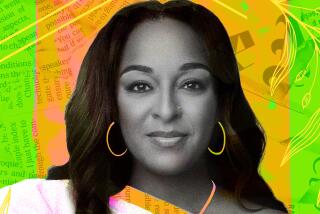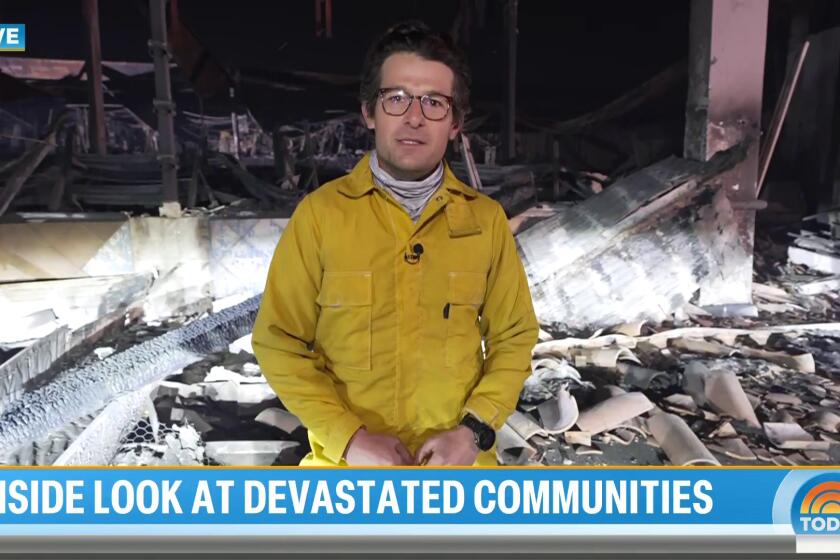A Special Post-Riot Forum for Los Angeles Artists : The arts: ‘The Verdict and the Violence,’ a compact disc with High Performance magazine, gives a voice to artists like singer Exene Cervenka and poet Roberto Bedoya.
R eginald Denny, he ain’t dead . . . he got what he deserved.
While city officials talk about “the healing process” and construction crews remove the charred remains of businesses, performance artist Keith Antar Mason dredges up the rage that sparked the disturbances following the verdict in the Rodney G. King trial.
And in the beauty of that moment was justice going upside his head. Blood drinking demon justice.
So says the enraged Mason, accompanied by his performance collective the Hittite Empire, on a new compact disc, “The Verdict and the Violence.” The recording accompanies a special edition of High Performance magazine and includes works by 20 artists on the riots, race and America.
Many listeners might find it disturbing to listen to Mason, who says he wanted to point out that “the whole nation knows about Reginald Denny, but not Louis Watson,” a reference to the 18-year-old African-American who was one of the first to die during the riots. (Police suspect a gang member was firing at Watson, who was shot outside a swap meet that was being looted at Vernon and Vermont.)
In his work, Mason questions why a white man, beaten but still alive, has received such an outpouring of sympathy, whereas African-Americans who were killed are ignored.
Did you see (Watson) die? . . . Did you go to his funeral? . . . Have you seen his death, America? Each time, the chorus replies: No.
The media’s meticulous coverage of Denny’s beating and recovery, Mason says, has been at the expense of others who suffered during the riots. “How does black history get lost?” Mason asked in an interview. “Who do you focus in on?”
Such outrage is just one artistic response to the riots that can be heard on the recording. “The Verdict and the Violence” also includes works by performance artist Linda J. Albertano, writer and singer Exene Cervenka, writer and actor Tony Abatemarco, actress Amy Hill, poet Roberto Bedoya and comic Steve Park.
This is the first time High Performance magazine, which occasionally produces albums and cassettes, has included a compact disc. Music by the L.A. group Seven 1 breaks up the works with the sound of a single trumpet mixed with the noise of sirens, helicopters and news reports. Looting, shop burnings and the beatings of King and Denny are remembered and used as metaphors.
A Latino man talks about hating his skin color and loving Marilyn Monroe. A white woman whispers about being afraid of the mob. And an Asian-American woman mourns charred Asian businesses. Where one artist remembers the riots as a fun time, another speaks of the horror of watching racism “in reverse and reverse and reverse.”
“There literally is a difference in how you see things,” says poet Wanda Coleman, associate producer of the recording and guest editor of the magazine, who brought together artists of varying ethnic backgrounds for the combined effort.
Coming out of meetings held days after the unrest, “The Verdict and the Violence” is a forum for L.A. artists, who Coleman argues have been ignored in the post-riot discussions. Instead of interviewing artists, she says, “the media have been breaking their asses to talk to gangsters.”
Coleman, who was in L.A. during the Watts riots in 1965, says she has been afraid that this time around, the same people would speak for her as they have in the past. “I knew anthologies would come out of (the riots) and I knew it would be the usual talking heads,” Coleman says. “This time, others are not going to speak for us.”
Before the immediacy of the riots was lost, Coleman and producer Mari Sunaida moved fast to put the recording together in a week. Killer Studios in Hollywood donated studio time and the recording’s executive producer, Jonathan Haft, donated $8,500. “People put up money for garbage,” said Haft, a musician and producer. “I was so disillusioned with recording companies and cutting through their bureaucracy. No one wanted to put money up for this.”
Sunaida is not new to producing multiethnic projects. She also put together “Seoul to Soul,” an event held before the King verdict in response to tensions that arose after a Korean grocer was given probation in the shooting death of a black girl.
This time, Sunaida says, she wanted to get to the heart of “why the riots happened.”
“I was gunning for a large perspective . . . an epic sweep . . . to open it up to a discussion of America in general,” Sunaida says. “It’s not that I agree with what everyone says. But I think it’s important for everyone to be heard.”
To heal, Sunaida says, you need to first hear everyone’s story and viewpoint. “We’re bumping up against each other in L.A.,” Sunaida says, and because of that, the riots weren’t the same for everyone. For example, one take on the riots in the collection is “Untitled,” by African-American stand-up comic Satoori Shakoor, who says she tried to remove the judgment out of words such as looters and thieves.
Some people needed Pampers, some people needed some food, and some people were just having fun. For 36 hours, people could have access to anything they wanted and a police car just drove on by. It was worth it and in fact some of the looters took things back because life is an experience.
But another example is Lisa Rafel’s “Emergency Plan,” where a white woman describes driving home during the riots as a prowling pack “tore the terrain with its teeth and didn’t look back. . . . No one hunted me that night, but my heart is half eaten.”
For Coleman, the latest unrest is a second chance for herself and local artists to create something out of the violence and the destruction.
“I get angry about Watts. What happened with the energy there? It was diffused,” Coleman says.
“I want to be able to say to my grandchildren, ‘ This is really what it was like.’ ”
More to Read
The biggest entertainment stories
Get our big stories about Hollywood, film, television, music, arts, culture and more right in your inbox as soon as they publish.
You may occasionally receive promotional content from the Los Angeles Times.










